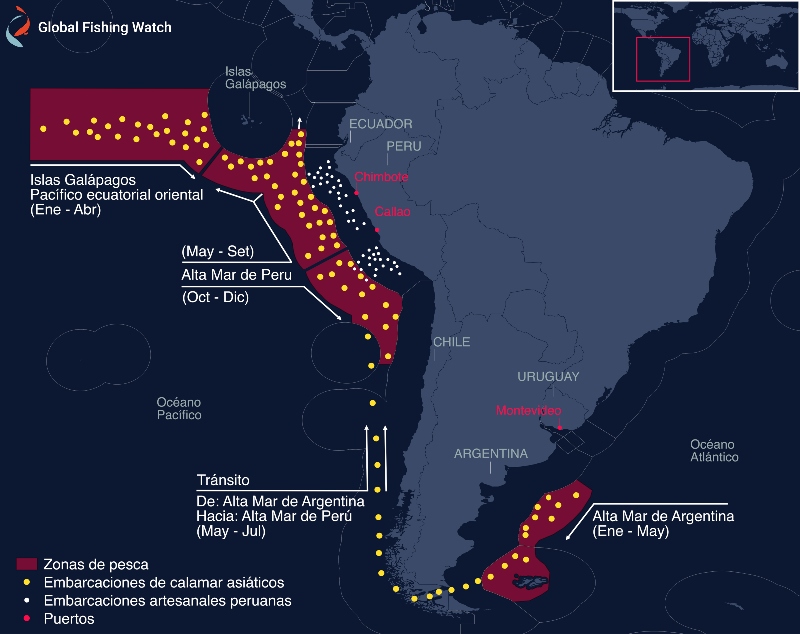|

Photo: Mongabay Latam
Chinese fleet dodges satellite monitoring by Peruvian authorities
 PERU
PERU
Thursday, April 13, 2023, 07:00 (GMT + 9)
The following is an excerpt from an article published by Mongabay:
- Since Peru required foreign vessels that want to use its ports to carry an additional satellite system in 2020, only five Asian vessels have installed the device.
- Instead, half of the foreign fleet has preferred to bear the cost of returning to Chinese ports or staying longer at sea. The latter could increase the risk of forced labor.
- Representatives of the Peruvian fishing sector fear that the control regulations in Peru will become more flexible due to pressure from China.
As every year, the Chinese fleet that fishes for giant squid off the seas of Latin America is on the outskirts of Argentine territory during the month of April. In May it is estimated that they will begin to cross the Strait of Magellan towards the South Pacific to settle down to fish off the seas of Ecuador and Peru.

Chilean Air Force pilot flies over Chinese jiggers crossing the Strait of Magellan
Although it is a movement that is repeated every year, the specialists who monitor the operations of the Chinese fleet through satellite instruments have observed important differences in recent times.
Since Peru established a regulation in 2020 that requires foreign vessels that use Peruvian ports to carry an additional satellite device to the one they already bring, the behavior of Chinese and Korean ships has not been the same.
Artisonal, a consulting company specialized in fishing issues that was born in 2022 and is already developing projects together with Oceana and Conservation International, analyzed official data from the Ministry of Production, the Peruvian Port Authority and the Global Fishing Watch satellite platform. .

The findings published this Wednesday, April 12, show that the ships of the Asian fleet that normally used the ports of Callao and Chimbote, have begun to return to Chinese ports - and assume the inconvenience in time and money that this transfer implies. — instead of installing the satellite device required by Peru. In addition, ships are spending more time at sea, which could be impacting the health of the crew and increasing the risks of forced labor.
Chinese vessels dodge monitoring attempts
In August 2020, Peru established a regulation that requires foreign vessels that use the country's ports to carry an additional satellite device to the one they already bring. In this way, the Peruvian authorities can know more precisely what the route and movements of the ship were before entering the port.
.png)
Click on the image to enlarge it
The provision was celebrated by representatives of the fishing sector and by researchers since, according to an analysis carried out by the Global Fishing Watch (GFW) satellite monitoring platform, some Chinese vessels could have been turning off their satellite system at the limits of the Peruvian sea to fish. illegally.
However, to date "only five foreign squid boats (three Chinese and two South Koreans) have Peruvian VMS (satellite system) equipment," says an investigation published today by the consulting company Artisonal. According to Alfonso Miranda, president of the Committee for the Sustainable Management of Giant Squid (Calamasur) —a group made up of players from the squid industry in Chile, Ecuador, Peru and Mexico— the reason given by Chinese fishing vessels for not installing the system is the cost of the device. For Miranda, said pretext is "a gross lie", since "even artisanal vessels put satellite devices on board. We are already ripe enough for them to tell us that story,” he says.
.png) For the president of Calamasur, the real reason is that they do not want to be monitored. “If the owner does not want to put a VMS on his boat so that the Peruvian authorities can verify that they were fishing according to the regulations before entering the port, why? We are not asking you to do anything that is not written in the standard. They just don't want to be transparent about showing what they're doing,” he says. Eloy Aroni, representative of Artisonal, agrees. “It is not a cost issue. It's because they don't want to be monitored. They are not willing for another country to see their activity.” For the president of Calamasur, the real reason is that they do not want to be monitored. “If the owner does not want to put a VMS on his boat so that the Peruvian authorities can verify that they were fishing according to the regulations before entering the port, why? We are not asking you to do anything that is not written in the standard. They just don't want to be transparent about showing what they're doing,” he says. Eloy Aroni, representative of Artisonal, agrees. “It is not a cost issue. It's because they don't want to be monitored. They are not willing for another country to see their activity.”
Income to Peruvian ports by the distant water squid fleet
Increase of income to ports under the concept of "forced arrival" after the entry into force of D.S. N° 016-2020-PRODUCE that orders the installation of VMS devices for the use of Peruvian ports.
So much so that the data analysis carried out by Artisonal, based on public information from the Global Fishing Watch platform, shows that after the entry into force of the regulation, half of the Chinese fleet that operates off the Peruvian sea preferred to return to Chinese ports. This, says Aroni, "is not very convenient for the boat" because it takes about five months to go to China and return to the fishing area off the Peruvian sea.
.jpeg)
Chinese crew fishing for squid outside the Peruvian EEZ
Even so, the expense in time and fuel seems to be more convenient than installing the satellite system that Peru requires to continue using Peruvian ports, experts say.
The fact that a minimum number of foreign vessels have installed the device required by Peru has had its repercussions. There is a decrease in the arrivals of Chinese ships to Peruvian ports such as Chimbote and Callao, which had become the main refueling, maintenance and crew change points for this fleet in the South Pacific, the Artisonal report says. So much so that in 2019 up to 300 port entries were registered by vessels from the foreign squid fleet. “But after the new port regulation was enacted in 2020, this value dropped dramatically to just 40 port entries,” the report added.
.png)
Chinese fisherman with a Peruvian giant squid (dosidicus gigas)
As Miranda explains, the arrivals of foreign ships generate profits that Peru would not be receiving. “When a ship arrives, the port wins. The shipyards win, there are people who benefit ”, he specifies. Thus, by reducing arrivals, China would be putting economic and political pressure to "manage with the Peruvian authorities that the rule be repealed or modified in such a way that it is neutralized," says the president of Calamasur.
Miranda and other actors in the fishing sector denounce that "an attempt is currently underway to make the rule more flexible." That, they say, would be equivalent to repealing it. "What they want is to give the vessels the opportunity to enter the Peruvian port and to be able to install the satellite system there," says Miranda.
.png)
Chinese jigger ship doing hull maintenance and painting in Peruvian port
The most important service used by foreign ships in Peruvian ports is the maintenance of the part of the hull that remains sunk. “This must be done once every two years, two and a half years at the most, because that helmet already begins to have a risk of wear and the insurance companies do not provide coverage if one does not do the maintenance,” explains Miranda.
“If I am going to enter a Peruvian port (to install the satellite system) and I am going to use that pretext to bring ships in and take them out, then I do not need to enter again and in two more years we will see with which authorities we can change the norm”, adds the representative. In practice, "to do this would be to open a window through which what is being done is really to repeal the supreme decree and control," he says.
Mongabay Latam sent questions to the Ministry of Production (PRODUCE), however, until the publication of this article the ministry did not provide answers.[continues...]
Author: Michelle Carrere/ Mongabay | Read the full article by clicking the link here (only available in spanish)
Related news:
.jpg)
[email protected]
www.seafood.media
|



